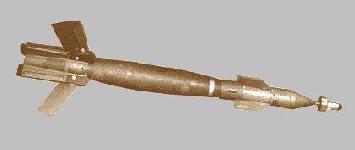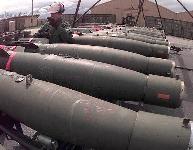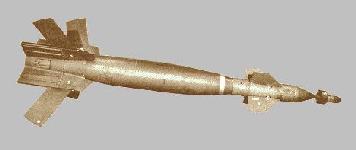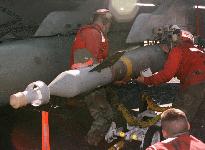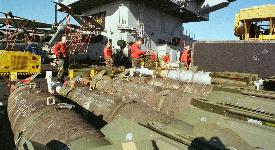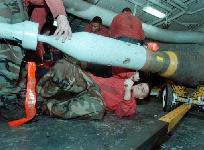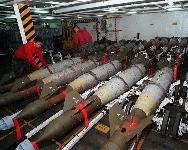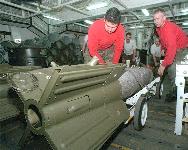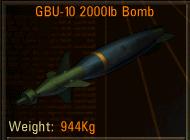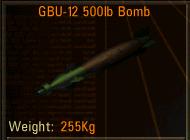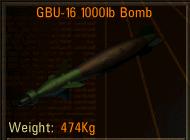
Info about the "Air to Ground" Missiles...
Laser Guided Bomb Units (GBU s)...
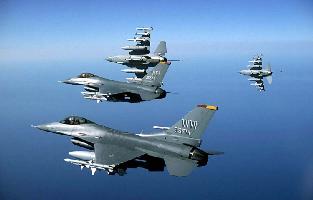
Background...
It has long been clear that the free-fall or "iron" bomb is a cheap weapon that is also highly effective if it hits its
target. Early experience in the Vietnam War (US involvement between 1961 and 1973) persuaded the US Air Force that even
its most advanced sights were inadequate to provide the free-fall bomb with the terminal accuracy for the destruction of
point targets without an enormous and therefore costly expenditure of such weapons in large numbers of sorties that were
also likely to result in the loss of highly trained aircrew and their valuable warplanes. During the mid-1960s, therefore,
considerable effort was expended in the creation of a program to improve the terminal accuracy of free-fall bombs. One of
the key elements in this program had been started in 1965 by the Armament Development and Test Center at Eglin AFB,
Florida, with the industrial partnership of Texas Instruments, with the intention of creating a cheap system for giving
any of the Mk 80 series and other tactically important free-fall bombs, most notably the 750 lb (340 kg) M117 and 3,000
lb (1,361 kg) weapons, a high degree of terminal accuracy by the addition of a semi-active laser homing system and
associated control package. This program led to the "Paveway" series of laser-guided bombs, of which the first were
introduced in 1967 after the initial release of a laser-guided development weapon in 1965. The designation "Paveway I"
was adopted only in 1978, when a PEP (Production Engineering Program) was started for an overall improvement in
laser-guided bomb capabilities, and is used for a series of add-on laser-homing kits, which are marked-target seekers
and associated control surfaces developed by Texas Instruments. Each kit, designed to be added on the nose of the basic
bomb, weighed about 30 lb (13.6 kg) and increased the bomb's overall length by some 6 in (0.15 m): the complete unit was
in fact 3 ft 4 in (1.01 m) long, but this was offset by a reduction in the length of the tail surfaces, which were fixed
surfaces of trapezoidal planform. The kit could be fitted to standard low-drag bombs for maximum accuracy when used in
conjunction with an air- or ground-based laser designator.
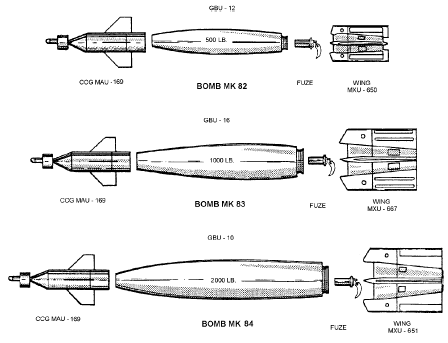
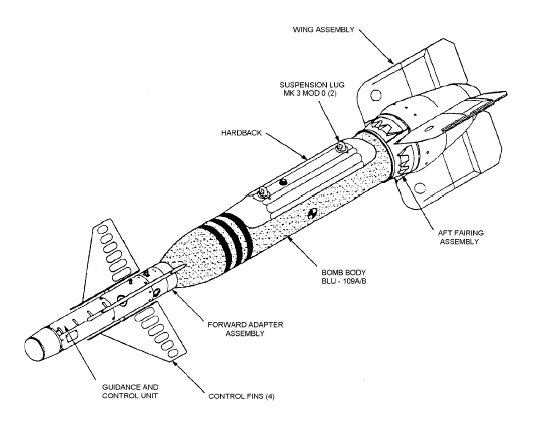
The "Paveway I" soon proved in operations from 1968 that its primary benefit, other than the very high degree of terminal
accuracy, was that the launch warplane needed no modification to carry the weapon and after weapon release could depart
from the target area unless it was also the laser-designator machine. The system worked at night and in poor visibility,
and the minimum cloud base for successful operation was 2,500 ft (760 m). The airborne designators most commonly associated
with the series were three podded systems, the AVQ-23A "Pave Spike" day, AVQ-26 "Pave Tack" day and night, and LANTIRN
(Low-Altitude Navigation and Targeting Infra-Red for Night) day and night units carried by many US tactical warplanes
such as the General Dynamics F-111 interdictor, the Lockheed Martin F-16 Fighting Falcon multi-role fighter, and the
McDonnell Douglas F-4E Phantom II and F-15 Eagle multi-role fighters. Moreover, any warplane capable of lifting the
baseline "iron" bomb could deliver a "Paveway I" weapon against a target designated by a third party. In all cases the
guidance unit was the same, the differences between the various systems lying in their attachments and variously enlarged
fins. The guidance system drew current from a thermal battery activated at launch, and was steered by canard control fins
powered by a hot gas generator.
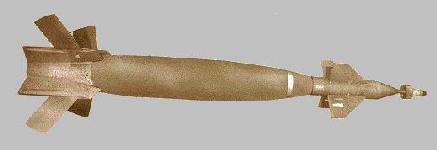
Laser Guided Bomb Unit-10 (GBU-10) "Paveway I"...
Resulting from the Production Improvement Program effort and entering service in 1980, this is an improved series based on
the same basic concept but with a simpler (thus cheaper) guidance package and a folding wing group (comprising spring-open
extensions to the fixed tail fins for extra maneuverability and additional horizontal range) added at the tail. The weapons
within this important basic designation are : GBU-10C/D/E/F "Paveway II" based on the 2,000 lb. Mk 84 bomb GBU-10G/H/I/J
"Paveway II" based on the 2,000 lb. BLU-109/B Improved 2,000 lb Penetrating Warhead GBU-12B/C/D "Paveway II" based on the
500 lb. Mk 82 bomb GBU-16A/B "Paveway II" based on the 1,000 lb. Mk 83 bomb Mk 13/18UK "Paveway II" based on the 1,000 lb.
British Mk 13/18 bomb In each case the weapon functions in a manner basically similar to that of the "Paveway I" series:
the 3.25 in (0.0825 m) diameter freely gimbaled laser seeker at the extreme nose is aligned by its 6.25 in (0.159 m) ring
tail with the velocity vector of the falling bomb, and detects laser radiation (reflected from the "illuminated" target)
at different strengths on each of its four internal quadrants; this strength differential is used to generate error signals
passed to the computer in the 8 in (0.20 m) section just forward of the canard control fins; the computer turns these
inputs into commands to the four solenoids operating the cruciform of canard control fins (spanning 2 ft 7.25 in/0.79 m
in the GBU-10 and 1 ft 5.65 in/0.49 m in the GBU-12), steadily reducing the angular difference between the seeker's line
of sight and the velocity vector of the bomb to zero, at which point an equal strength of laser radiation is being received
by each of the seeker's quadrants as the weapon is falling directly towards the target. Operational service revealed that
while the system was extremely accurate, the use of a 'bang/bang' control system, in which the control surfaces were moved
to their maximum deflection position each time a command was received, increased drag and therefore reduced range.
Laser Guided Bomb Unit-10/12 (GBU-10/12) "Paveway I - II"...
The Guided Bomb Unit-10 (GBU-10) utilizes the 2,000-pound general purpose or penetrating warhead. The operator illuminates
a target with a laser designator and then the munition guides to a spot of laser energy reflected from the target. The
GBU-10 consists of an MK-84 2,000 pound bomb with an added laser guidance package. The GBU-1OI mates a BLU-109B weapon
with a Paveway II laser guidance kit. This improved 2,000-pound bomb is used against targets requiring deeper penetration.
The munition was used during Operation Desert Storm, and, according to the Air Force, hit 78 percent of its targets. In
Operation Desert Storm, GBU-10/10Is were used extensively by F-15Es and F-111Fs mainly against bridges, Scuds, C3I
(command, control, communications, intelligence) nodes, and bunkers. There are two generations of GBU-10 LGBs : Paveway I
with fixed wings and Paveway II with folding wings. Paveway II models have the following improvements: detector optics and
housing made of injec- tion-molded plastic to reduce weight and cost; increased detector sensitiv- ity; reduced thermal
battery delay after release; increased maximum canard deflection; laser coding; folding wings for carriage, and increased
detector field of view. (Paveway II's instantaneous field of view is thirty percent greater than that of the Paveway I's
field of view).
Laser Guided Bomb Unit-12 (GBU-12) "Paveway II"...
The Guided Bomb Unit-12 (GBU-12) utilizes a 500-pound general purpose warhead. The operator illuminates a target with a
laser designator and then the munition guides to a spot of laser energy reflected from the target. The munition was used
during Operation Desert Storm, and, according to the Air Force, hit 88 percent of its targets. During Desert Storm the
GBU-12 was dropped by F-lllFs, F-15Es, and A-6s, mostly against fixed armor. It was the F-111F tank-busting weapon of
choice. Of the 4,493 GBU-12s employed, over half were dropped by the F-lllF.
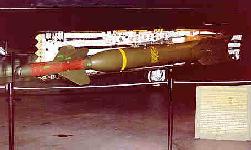
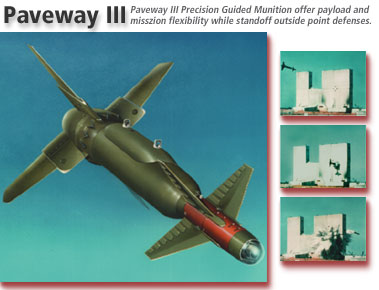
There are two generations of GBU-12 LGBs: Paveway I with fixed wings and Paveway II with folding wings. Paveway II models
have the following improvements: detector optics and housing made of injection-molded plastic to reduce weight and cost;
increased detector sensitivity; reduced thermal battery delay after release; increased maximum canard deflection; laser
coding; folding wings for carriage, and increased detector field of view. (Paveway II's instantaneous field of view is
thirty percent greater than that of the Paveway I's field of view).






